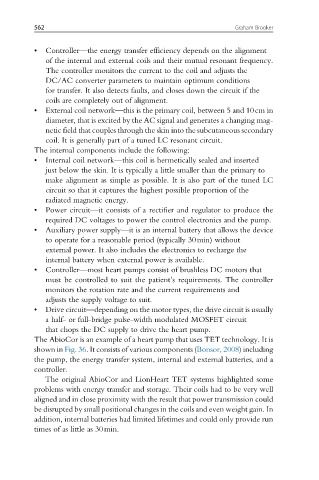Page 569 - Handbook of Biomechatronics
P. 569
562 Graham Brooker
• Controller—the energy transfer efficiency depends on the alignment
of the internal and external coils and their mutual resonant frequency.
The controller monitors the current to the coil and adjusts the
DC/AC converter parameters to maintain optimum conditions
for transfer. It also detects faults, and closes down the circuit if the
coils are completely out of alignment.
• External coil network—this is the primary coil, between 5 and 10cm in
diameter, that is excited by the AC signal and generates a changing mag-
netic field that couples through the skin into the subcutaneous secondary
coil. It is generally part of a tuned LC resonant circuit.
The internal components include the following:
• Internal coil network—this coil is hermetically sealed and inserted
just below the skin. It is typically a little smaller than the primary to
make alignment as simple as possible. It is also part of the tuned LC
circuit so that it captures the highest possible proportion of the
radiated magnetic energy.
• Power circuit—it consists of a rectifier and regulator to produce the
required DC voltages to power the control electronics and the pump.
• Auxiliary power supply—it is an internal battery that allows the device
to operate for a reasonable period (typically 30min) without
external power. It also includes the electronics to recharge the
internal battery when external power is available.
• Controller—most heart pumps consist of brushless DC motors that
must be controlled to suit the patient’s requirements. The controller
monitors the rotation rate and the current requirements and
adjusts the supply voltage to suit.
• Drive circuit—depending on the motor types, the drive circuit is usually
a half- or full-bridge pulse-width modulated MOSFET circuit
that chops the DC supply to drive the heart pump.
The AbioCor is an example of a heart pump that uses TET technology. It is
shown in Fig. 36. It consists of various components (Bonsor, 2008) including
the pump, the energy transfer system, internal and external batteries, and a
controller.
The original AbioCor and LionHeart TET systems highlighted some
problems with energy transfer and storage. Their coils had to be very well
aligned and in close proximity with the result that power transmission could
be disrupted by small positional changes in the coils and even weight gain. In
addition, internal batteries had limited lifetimes and could only provide run
times of as little as 30min.

